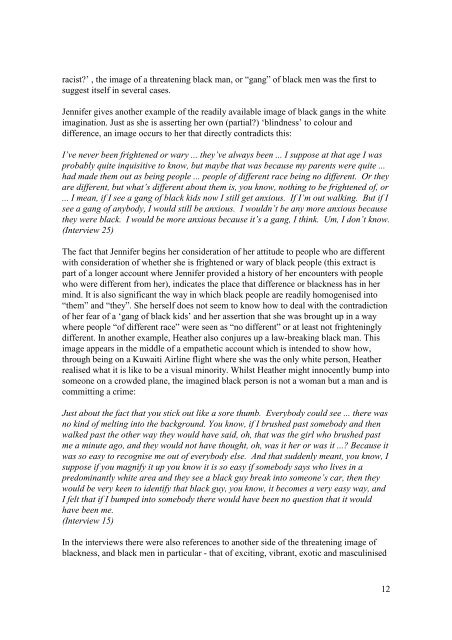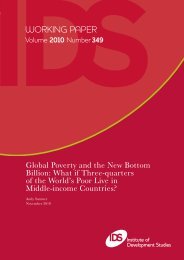1 'Troubling race. Using Judith Butler's work to think about racialised ...
1 'Troubling race. Using Judith Butler's work to think about racialised ...
1 'Troubling race. Using Judith Butler's work to think about racialised ...
Create successful ePaper yourself
Turn your PDF publications into a flip-book with our unique Google optimized e-Paper software.
acist?’ , the image of a threatening black man, or “gang” of black men was the first <strong>to</strong><br />
suggest itself in several cases.<br />
Jennifer gives another example of the readily available image of black gangs in the white<br />
imagination. Just as she is asserting her own (partial?) ‘blindness’ <strong>to</strong> colour and<br />
difference, an image occurs <strong>to</strong> her that directly contradicts this:<br />
I’ve never been frightened or wary ... they’ve always been ... I suppose at that age I was<br />
probably quite inquisitive <strong>to</strong> know, but maybe that was because my parents were quite ...<br />
had made them out as being people ... people of different <strong>race</strong> being no different. Or they<br />
are different, but what’s different <strong>about</strong> them is, you know, nothing <strong>to</strong> be frightened of, or<br />
... I mean, if I see a gang of black kids now I still get anxious. If I’m out walking. But if I<br />
see a gang of anybody, I would still be anxious. I wouldn’t be any more anxious because<br />
they were black. I would be more anxious because it’s a gang, I <strong>think</strong>. Um, I don’t know.<br />
(Interview 25)<br />
The fact that Jennifer begins her consideration of her attitude <strong>to</strong> people who are different<br />
with consideration of whether she is frightened or wary of black people (this extract is<br />
part of a longer account where Jennifer provided a his<strong>to</strong>ry of her encounters with people<br />
who were different from her), indicates the place that difference or blackness has in her<br />
mind. It is also significant the way in which black people are readily homogenised in<strong>to</strong><br />
“them” and “they”. She herself does not seem <strong>to</strong> know how <strong>to</strong> deal with the contradiction<br />
of her fear of a ‘gang of black kids’ and her assertion that she was brought up in a way<br />
where people “of different <strong>race</strong>” were seen as “no different” or at least not frighteningly<br />
different. In another example, Heather also conjures up a law-breaking black man. This<br />
image appears in the middle of a empathetic account which is intended <strong>to</strong> show how,<br />
through being on a Kuwaiti Airline flight where she was the only white person, Heather<br />
realised what it is like <strong>to</strong> be a visual minority. Whilst Heather might innocently bump in<strong>to</strong><br />
someone on a crowded plane, the imagined black person is not a woman but a man and is<br />
committing a crime:<br />
Just <strong>about</strong> the fact that you stick out like a sore thumb. Everybody could see ... there was<br />
no kind of melting in<strong>to</strong> the background. You know, if I brushed past somebody and then<br />
walked past the other way they would have said, oh, that was the girl who brushed past<br />
me a minute ago, and they would not have thought, oh, was it her or was it ...? Because it<br />
was so easy <strong>to</strong> recognise me out of everybody else. And that suddenly meant, you know, I<br />
suppose if you magnify it up you know it is so easy if somebody says who lives in a<br />
predominantly white area and they see a black guy break in<strong>to</strong> someone’s car, then they<br />
would be very keen <strong>to</strong> identify that black guy, you know, it becomes a very easy way, and<br />
I felt that if I bumped in<strong>to</strong> somebody there would have been no question that it would<br />
have been me.<br />
(Interview 15)<br />
In the interviews there were also references <strong>to</strong> another side of the threatening image of<br />
blackness, and black men in particular - that of exciting, vibrant, exotic and masculinised<br />
12

















